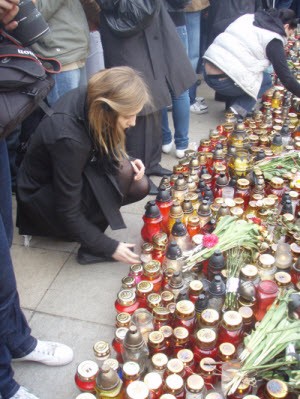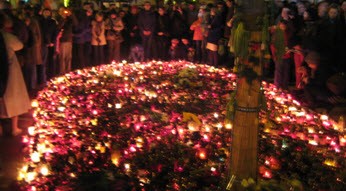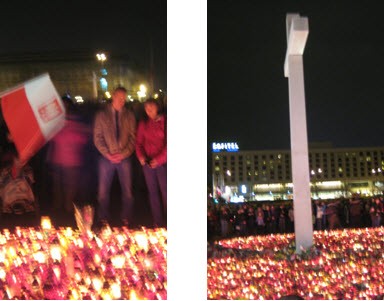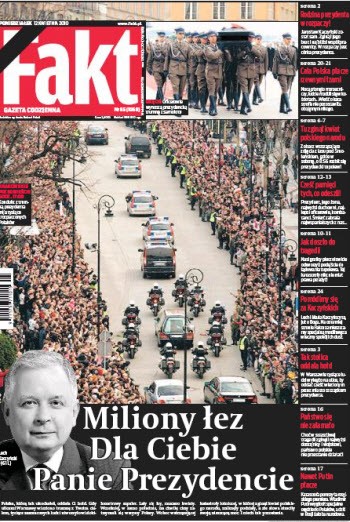There was a persistent wailing of sirens, as for two minutes Warsaw, along with the rest of the Polish nation, remembered the tragedy that had befallen them, only twenty-four hours earlier. The Royal Trail, the long avenue leading through Warsaw to the Old Town, swelled with thousands of flickering candles, taking up twice as much space as the mourners gathering to honour the President, Lech Kaczyński, his wife and ninety-five civic leaders, parliamentarians and military advisors who perished in Russia’s Smoleńsk, after their aircraft hit trees.

A sense of absurdity prevails. The delegation’s destination was the Katyń forest where, seventy years after Stalin sanctioned a massacre of 20,000 members of the Polish intelligentsia, they were to commemorate one of the most cynical events of WWII. Only three days earlier, Putin had visited the site along with the Polish prime minister, Donald Tusk; the first Russian representative to commemorate the massacre since the graves were discovered in 1943.
There is no denying the tragedy has taken on a mystical tone. Barely an hour after the accident happened, a pilgrimage towards the presidential palace had already begun and mourners, carrying flowers and candles, could barely be contained within the Old Town’s arteries. Expressions such as, ‘our second Katyń’, were quick to spread, and many mourners likened the tragedy to the loss of ‘another Polish hero’, John Paul II, only five years earlier. Eight hours after the accident, mass was held, as dazed newlyweds promptly evacuated churches and cathedrals across the city.
On the second day, there are questions. Why did the pilot choose to ignore the advice to land at Minsk airport, after four aborted landings? Why was the aging, Soviet-manufactured presidential fleet not replaced earlier? And why were so many important people on board one aircraft? Two years ago some of the country’s top bomber pilots perished in a crash near Poznań, and a commission had banned that tier of professionals from flying altogether. Poland’s top military advisers, many of its MPs and scores of civic leaders perished in Saturday’s crash, and many cannot believe that the same mistake could be repeated, on such a scale.
The leading newspapers run fresh editions every few hours, with headlines such as Gazeta Wyborcza’s Poles Farewell Lech and Maria Kaczyński, Rzeczpospolita’s Poland’s Most Tragic Golgotha, and Dziennik’s Poland Devastated After Smoleńsk.
Outside cathedrals, boyscouts hand out commemorative runs of Rzeczpospolita, with obituaries for each of the dead.
There have also been some changes. While the foreign press is quick to emphasise Kaczyński’s poor relations with the Kremlin, the Polish media broadcasts Putin in real-time, tirelessly working with a visibly shaken Prime Minister Donald Tusk. There is not one person in the country who does not now carry the fantastical image of Tusk stumbling, while laying a wreath at the crash site, only to be caught in Putin’s embrace. In the crowds surrounding the presidential palace, news travels fast that Russia’s national broadcaster has scheduled a screening of Andrzej Wajda’s film, Katyń. The Polish media is greatful to Russia. There has been a shift.
As the second-day of mourning comes to a close, more pragmatic concerns are beginning to take center stage. Traveling with the President, were two more of the candidates for the upcoming presidential election (Kaczyński was to run again). The fourth, and last viable candidate, Bronisłąw Komorowski is, as speaker of the house, now acting-president. Of similar concern is the now-defunct opposition- many of Kaczyński’s Law and Justice party were on the flight with him. More pressing is the loss of Poland’s main military advisory committee- its top military advisors having perished alongside the others. Poles know as well as anyone that had their country been unstable, this could have spelled disaster.
There is, however, also optimism. People walk the streets of the Old Town, surrounded by an air of calm, without a hint of the unnerving reasons that have brought them there. “What I think we’ve seen here today, is that Polish democracy has passed a big test,” says Julia Gruszczyńska, walking towards Plac Piłsudskiego, where mourners have gathered around a flagpost. She is right. Once there, a group can be seen surrounding a figure, embracing him. It is Komorowski, their new head of state. He has been legitismised. Later, when the hearse carrying Lech Kaczyński’s body snakes through Warsaw’s main avenues, his detractors and supporters stand by solemnly. Embodied in him, is the sovereignty of the state, and it is this, which Poles have today come to observe.
Meanwhile, Vince Chadwick writes from Warsaw:
It is uncommon in a country as Catholic as Poland to speak of a curse, but the word has been used more than once here to describe the woods around Smolensk. Those killed on Saturday morning were not only the political elite of modern independent Poland, but also those who had fought hardest to have the legacy of the Katyn massacre recognised. In 1940 Stalin’s NKVD had sought to eliminate a generation of Poland’s best officers, doctors and lawyers and then covered up their crime for decades. The fact that this time it was cruel fate alone that intervened in the same place, has many Poles looking for a reason, some sign that what occurred may come to own some larger significance.
In a small town outside Warsaw, not even the dogs barked. At 2pm the body of President Lech Kaczynski arrived back in the capital at the same airport where his ill-fated Tupolev Tu-154 jet had taken off less than 48 hours earlier. A motorcade travelled the 15 kilometres to the presidential palace down streets lined with mourners. Many people crossed themselves by the side of the road, some threw flowers or filmed with mobile phones — but what was discernible was the silence, deep and intractable.
The past two days in Poland have been a lesson in private and public mourning. Internal and national. Stoic and unbridled. From the first minutes following the plane crash on Saturday all major television networks broadcast against a black background. Websites are in black and white and the ubiquitous flags flying from Poles’ windows are tied with a black ribbon.
Almost every household in Poland keeps a flag for days of national celebration, but the ribbon has to be fashioned from whatever is at hand, often gaffer-tape or strips of clothing. Throughout the first day FM radio played only funeral marches. On Sunday the tone is more circumspect, the music not yet containing a beat but hinting at major keys and a lighter timbre.
By the evening of the second day the crowds gathering next to the presidential palace had not waned. With the return of their president, more people had come out into the early spring evening. Approaching the official residence the first sensation is the smell of a thousand of candles, “that first of November smell”, said a friend in a reference to All Saints day. This is quickly followed by the candles’ heat, distinguishable from the heat of the crowd by their intensity. The gates of the residence are overflowing and people have left them under statues or particularly beautiful trees on the main street.

And so despite the strains of Mozart’s Requiem wafting out of the open doors of the large church at the entrance to the old town, the atmosphere is not that of a funeral. There are no tears, just quite reflection. A man is jostled while lifting his camera to take a photo and cries out, though he is not chastised. People smile faintly, as if too much has happened to justify worrying over this.

Many have looked to the Russian-Polish relationship with the hope that the usually reserved Vladimir Putin’s public embrace of Polish PM Donald Tusk as he arrived to escort his president home portends a detente in previously strained relations. It would perhaps be a fitting irony if a Pole, who spent his life’s work in the Solidarity movement of the 1980s and as president agitating for greater Polish autonomy from Russia, came to symbolise in death the beginning of an unheralded period of bipartisanship.
But tonight is not a night to plot politics. Instead people gather around a cross in Place Pilsudski to sing the favorite Polish song of John Paul II — who also died five years ago, on the Saturday after Easter. No country should be asked to endure this much, but if any country can, it is this one.








Thank you Paulina and Vince for your articles, both moving and analytical. And thanks to crikey to publishing such intelligent pieces for people in Australia who interested in events in Poland, Russia and elsewhere in Europe.
The image of the Tusk/Putin embrace seemed to have great power to me. Good news that it is being seen positively in Warsaw
Kaczynski resisted the Euro currency in favour of the Polish Zlotz and the national interests of the people of Poland, not a good look within European hegemony.
He also sought to weaken the Polish Zlotz to provide better balance of payments and extract better conditions for Polish exporters, also not a good look in the face of international investors who punted the currency in the opposite direction.
Thanks for the article, A very influential person in the Solidarity movement, and a man of unity and freedom.
The UK too resisted the Euro, now i know different circumstances, but there were good reasons with sticking with the Zloty, a lot of those conditions created for those exporters includes high-tech products, creating more skills and jobs which wern’t there, in due time they will change currency, but after this gfc they probably made the right choice in the long run.
Reports today are that President Kacynski had past form in directing his pilots to land in dangerous conditions. He obviously hadn’t heard of the old flyers axiom – there are old pilots and bold pilots but there are no old, bold pilots. Being a president doesn’t protect you from the effects of bad decisions. let’s hope some lessons are learn’t from this tragic incident.
BakerBoy:
All very nice, but that was not my inference.